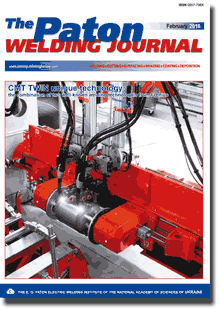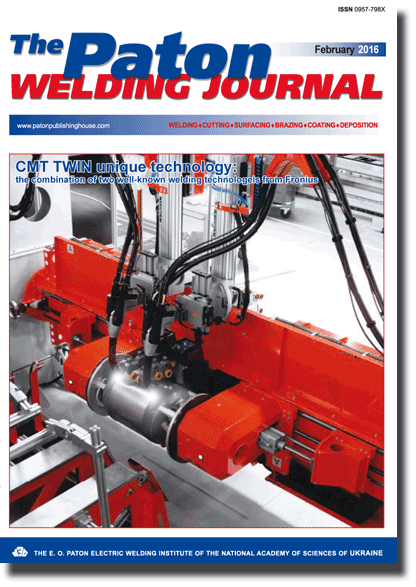| 2016 №02 (03) |
DOI of Article 10.15407/tpwj2016.02.04 |
2016 №02 (05) |

The Paton Welding Journal, 2016, #2, 22-27 pages
Evaluation of susceptibility to temper brittleness of heat-resistant steels using high-temperature testing
V.Yu. Skulsky1, V.V. Zhukov1, M.A. Nimko1, S.I. Moravetsky1 and L.D. Mishchenko2
1E.O. Paton Electric Welding Institute, NASU 11 Kazimir Malevich Str., 03680, Kiev, Ukraine. E-mail: office@paton.kiev.ua
2Company «Turboatom» 199 Moskovsky Ave., 61037, Kharkov, Ukraine. E-mail: office@turboatom.com.ua
Abstract
Main point of problem of crack formation in tempering is defined. It is shown that low metal ductility during plastic deformation, promoted by stress relaxation is a condition for nucleation of such cracks. Important brittleness factor under these conditions is temporarily developing secondary hardening, related with nucleation and precipitation of secondary phases in matrix. Since alloys with different level of alloying demonstrate different behavior during tempering, then evaluation of their possible tendency to temper brittleness is of interest in each specific case. A procedure is described for high-temperature tensile testing, which allows evaluating ductile properties of metal under different tempering conditions. Susceptibility to temper brittleness was evaluated using a criterion of value of relative reduction in area φ ≤ 25 %. Studied was a nature of ductility change in complexly-alloyed heat-resistant steels under different tempering modes resulting in secondary hardening condition and after hardening stage. It is shown that steels in a period of steel hardening development have low ductility with typical for such a state intergranular fracture. Determined are critical tempering modes, under which a high ductility state is achieved, based on which absence of susceptibility to tempering cracks can be predetermined. 9 Ref., 1 Table, 8 Figures.
Keywords: hardening steels, tempering, cracks, secondary hardening, tempering ductility, high ductility condition
Received: 05.11.15
Published: 12.04.16
References
- Prager, M., Sines, G. (1971) Embrittlement of precipitation hardenable nickel-base alloy by oxygen. of ASME, 93(2), 112–119. https://doi.org/10.1115/1.3425217
- Zemzin, V.N., Shron, R.Z. (1978) Heat treatment and properties of welded joints. Leningrad: Mashinostroenie.
- Titova, T.I., Shulgan, N.A., Borovskoj, A.S. (2012) Current requirements to consumables for welding of petrochemical pressure vessels made from steel of 2.25Cr–1Mo–0.25V type. In: of Sci.-Techn. Conf. on Welding Consumables, 192–201. St.-Petersburg: PI.
- Vinkier, A.G., Pense, A.W. (1974) A review of underclad cracking in pressure-vessel components. WRC Bulletin, 197(August).
- Nawrocki, J.G., DuPont, J.N., Robin, C.V. et al. (2003) The mechanism of stress-relief cracking in a ferritic alloy steel. Welding J., 82(2), 25–35.
- Dix, A.W., Savage, W.F. (1971) Factors influencing strain-age cracking in Inconel X-750. Ibid., 50(6), 247–252.
- Olenin, M.I., Gorynin, V.I., Timofeev, B.T. et al. (2014) Nature of thermal brittleness of steels of NPP equipment and methods of its decrease. Voprosy Materialoved., 3, 167–173.
- Lundin, C.D., Khan, K.K. (1996) Fundamental studies of metallurgical causes and mitigation of reheat cracking in 11.4Cr–1.2Mo and 21.4Cr–1Mo steels. WRC Bulletin, 409(February).
- Lanskaya, K.A. (1976) High-chromium heat-resistant steels. Moscow: Metallurgiya.
Suggested Citation
V.Yu. Skulsky, V.V. Zhukov, M.A. Nimko, S.I. Moravetsky and L.D. Mishchenko (2016) Evaluation of susceptibility to temper brittleness of heat-resistant steels using high-temperature testing. The Paton Welding J., 02, 22-27.The cost of subscription/purchase order journals or individual articles
| Journal/Currency | Annual Set | 1 issue printed |
1 issue |
one article |
| TPWJ/USD | 384 $ | 32 $ | 26 $ | 13 $ |
| TPWJ/EUR | 348 € | 29 € | 24 € | 12 € |
| TPWJ/UAH | 7200 UAH | 600 UAH | 600 UAH | 280 UAH |
| AS/UAH | 1800 UAH | 300 UAH | 300 UAH | 150 UAH |
| AS/USD | 192 $ | 32 $ | 26 $ | 13 $ |
| AS/EUR | 180 € | 30 € | 25 € | 12 € |
| SEM/UAH | 1200 UAH | 300 UAH | 300 UAH | 150 UAH |
| SEM/USD | 128 $ | 32 $ | 26 $ | 13 $ |
| SEM/EUR | 120 € | 30 € | 25 € | 12 € |
| TDNK/UAH | 1200 UAH | 300 UAH | 300 UAH | 150 UAH |
| TDNK/USD | 128 $ | 32 $ | 26 $ | 13 $ |
| TDNK/EUR | 120 € | 30 € | 25 € | 15 € |
AS = «Automatic Welding» - 6 issues per year;
TPWJ = «PATON WELDING JOURNAL» - 12 issues per year;
SEM = «Electrometallurgy Today» - 4 issues per year;
TDNK = «Technical Diagnostics and Non-Destructive Testing» - 4 issues per year.


